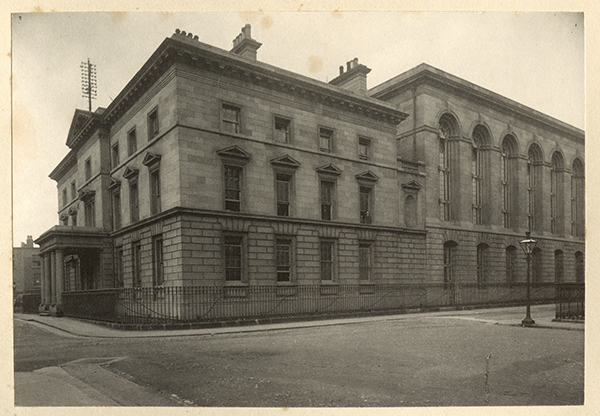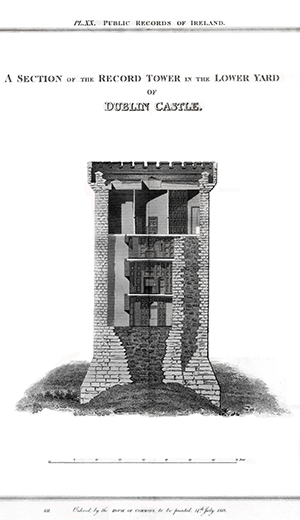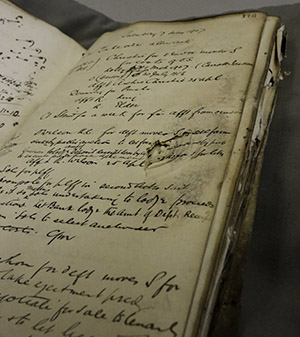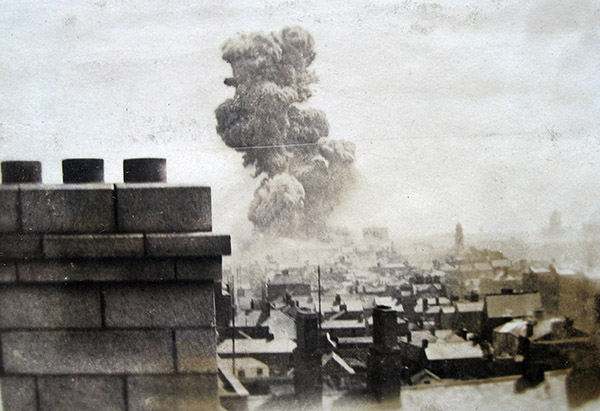SOURCES:‘The records of a country are its noblest inheritance’: Beyond 2022—Ireland’s Virtual Record Treasury research project
Published in Features, Issue 3 (May/June 2020), Volume 28In this, the first of three articles counting down to the centenary of the Four Courts fire in June 2022, the directors of Beyond 2022 examine the origins of the Public Record Office of Ireland and its magnificent collection, dating back to the twelfth century.
By Peter Crooks and Ciarán Wallace
The Beyond 2022: Ireland’s Virtual Record Treasury research project is working to reconstruct virtually the Public Record Office of Ireland, a national archive containing seven centuries of historical records destroyed at the outbreak of the Irish Civil War.
On the afternoon of 30 June 1922, Winston Churchill, Secretary of State for

Above: The Public Record Office of Ireland (PROI), at the Church Street side of the Four Courts complex, in 1915. Note the fire-break between the Record House (left) and the Record Treasury (right). (NAI)
the Commonwealth, was answering questions in the House of Commons. A telegram arrived while he stood at the dispatch box, with an update on the bombardment of the Four Courts in Dublin by the National Army. The Four Courts had been retaken, but the Record Treasury was burning. Churchill’s flippant comment to the House was that ‘a State without archives is better than archives without a State’.
On that terrible afternoon, hundreds of thousands of paper and parchment records were consumed in the fire at the Public Record Office of Ireland (PROI), including the great series of chancery and exchequer records that extended back to the thirteenth century and, oldest of all, the deeds of Christ Church Cathedral, which dated from 1174.
A thoroughly modern institution
Its contents may have been ancient but the PROI itself was in every sense a modern institution in conception, function and operation. It opened its doors in 1867 and operated for 65 years. That it existed at all was a response to vigorous lobbying. The middle decades of the nineteenth century witnessed intense public debate about Ireland’s records and their safe keeping. Ancient records were recognised as being the bedrock of rigorous, ‘scientific’ history-writing. A new term—‘archivism’—entered the lexicon to refer to professional record-keeping as a discipline in its own right, which should be practised by professional record-keepers, or ‘men of archivist tastes’, as one nineteenth-century record-keeper colourfully put it. The third characteristic of this debate was that the proper curation of the Irish public records was an issue of Irish national—or, depending on political stance, of British imperial—concern. In that light, Churchill’s later view that a state without archives was better than archives without a state would be beside the point. In an era of state growth and burgeoning national identities, the archive substantiated the state and undergirded the nation.

Above: Prior to the foundation of the PROI, Ireland’s public records were scattered across several locations, including the Record Tower of Dublin Castle. (Philip Maddock)
Prior to the foundation of the PROI, Ireland’s public records were scattered across several distinct locations, including the Record Tower of Dublin Castle, the Four Courts and the Custom House. The deplorable keeping of Irish records was thrown into sharp relief by the founding of London’s Public Record Office in 1838. Construction began on a new building in London in 1851. Appropriately enough for a building next to the medieval Rolls Chapel in Chancery Lane, the PRO London was conceived as a neo-Gothic masterpiece, designed by Sir James Pennethorn. In the same year as the works began in Chancery Lane, the editors of the organ that would become the Journal of the Royal Society of Antiquaries of Ireland complained bitterly of the miserable accommodation that Ireland’s records occupied:
‘The records of a country are its noblest inheritance. Few countries possess a more ample store of records than our own, but they have been, and are, sadly neglected. Much has been irretrievably lost by damp, by fire, and by peculation. The vaults of a custom house, the oubliettes of a state prison are thought good enough to be the depositories of much that remains. How long will it be ’ere their value is understood aright, and even common care taken to preserve them from defacement and decay?’
Construction begins in Dublin
After generations of neglect, the government introduced the Public Records (Ireland) Act in 1867, establishing the Public Record Office of Ireland. The new record office was a state-of-the-art premises located at the Church Street side of the Four Courts complex, designed to provide ample secure storage for the records together with a modern public reading room. Its architects were Enoch Trevor Owen (d. 1881) and Robert John Stirling (d. 1915), draughtsman of the Irish Board of Works.
Construction took place between 1864 and 1867, pursuant to the Four Courts (Dublin) Extension Act of 1858. The building was nearing completion in 1866, the year before the passage of the Public Records (Ireland) Act 1867. The repository was originally conceived of as a new archive for the courts. This explains why the Dublin Builder in July 1866 refers to the new building as the ‘General Law Record Repository’, describing it as ‘by far the most important in point of size and cost, of a public nature, that has been erected in Dublin for some years’. The cost of construction was estimated at £40,000.
The Public Records (Ireland) Act 1867 designated this new repository on Church Street as the Public Record Office of Ireland. The PROI consisted of two separate blocks, faced in cut granite. The first of these was the Record House, a three-storey building over basement approximately 28m by 17m, which contained the public Search Room and the Strong Room, whose windows were protected by iron bars. Here records could be stored safely overnight for readers who intended to return to consult them on the following day.
The Search Room was also connected via double doors and a fire-break isolation zone to the six-storey repository known as the Record Treasury, a large block with a vaulted basement and a main hall at ground-floor level with five galleries above. The interior of the Record Treasury was a large atrium (approximately 45m by 28m and 18m high), with light entering from an expansive glass roof running the entire length of the building and an arcade of ten tall arched windows along each side, complemented by two windows at the north end of the repository. With so much light entering the archive, the need for flaming gaslights could be avoided.
Two fire extinguishers and six buckets
On 19 November 1867 possession of the building was formally transferred to Samuel Ferguson, the first Deputy Keeper of the Records in Ireland, acting on behalf of the Master of the Rolls in Ireland. The memorandum recording the transfer of the building from the architect to its new custodian describes it as ‘the building erected in the neighbourhood of the Four Courts in Dublin, for the purpose of serving as a Public Record Office’.
Ironically, given its subsequent fate, the PROI was born in flames. One month after the Deputy Keeper took possession, and five days before Christmas, a fire broke out in the office of the Court of Chancery. According to the report, the fire ‘was not extinguished until the greater portion of the documents in that office was thrown into confusion and a considerable part of them damaged and destroyed’. The records rescued from the flames were immediately brought across to the new Record Treasury, still wet from the efforts of the fire brigade. There, in the vaulted basement, staff placed the salvaged records on temporary racks to dry. These would not be the last records to be salvaged from that basement.
Perhaps this early near-miss made the Deputy Keeper especially sensitive to the danger of fire. The Record House to the front of the block posed the greatest risk. Here the offices were heated by coal fires. The officials and the readers who pored over the records worked with the aid of gaslights, perhaps enjoying a pipe or a cigarette as they waited for the next batch of records to be produced. Because of this, the two sections—the Record Treasury and the Record House—were separated by the fire-break, a few metres wide with no facing windows and only one point of contact. To move between the buildings, double doors made of metal opened at ground level and led into a short metal passageway, at the far end of which another set of metal doors opened into the larger premises. In the event of a fire in the Record House both sets of doors could be shut, creating a fireproof airlock between the flames and the precious Record Treasury. A dry moat and wall surrounded both buildings, isolating them from the neighbouring courts offices.
Within the Treasury, the galleries and bays that held the records were constructed in ironwork. Where wood was required, the designers preferred sycamore because, if the worst happened, it would burn more slowly. They ‘impregnated’ the wood in the fittings with ‘anticombustive solutions’, removed all signs of lead paint and treated the walls with limewash. In 1874 the Board of Works approved a water supply to the basement, along with two fire extinguishers and six buckets, which, they said, ‘under proper management will be found sufficient to guard against fire’.
Filling the Record Treasury

Above: A battle-scarred ‘Judge’s Day Book’ from the Record House, with an entry for Tuesday 7 May 1907. (NAI)
With its new legal powers and enthusiastic management and staff, the PROI began the work of gathering all the ancient records from locations across the city and country. Over the late 1860s and into the 1870s workmen carted thousands of bundles of wills and judgements from the Four Courts across the yard to the PROI. Wagons loaded with medieval account rolls, sixteenth-century inquisitions and instructions from the court of Elizabeth I trundled through the streets of Dublin towards the Record Treasury. By the turn of the twentieth century the PROI had gained such a good reputation that non-State organisations with very old records asked to deposit them in the archive. The ancient trade guilds of Dublin survived into modern times as semi-social clubs, but their records stretched back to the Tudor era, and some even to the fifteenth century. The PROI accepted these important documents, even though they were produced by private organisations. Likewise, the descendants of the French Huguenots, Protestant refugees fleeing persecution in France in the 1680s and 1690s, deposited their earliest records in the PROI.
During this time Herbert Wood, a senior archivist who had risen to become Assistant Deputy Keeper, completed his Guide to the records preserved in the Public Record Office of Ireland. In almost 400 pages, Wood’s guide lists the PROI’s major collections (Exchequer, Chancery, Chief Secretary’s Office, etc.) and the series of records within each collection. This first attempt at a comprehensive overview of what was in the building represented a major advance in knowledge. The text was ready to go to the printer in early 1916.
When the 1916 Rising broke out, the rebels occupied prominent buildings around Dublin, including the entire Four Courts complex. A week’s occupation and some intense rifle fire did little damage to the stone structure or its contents. Following the general surrender, the building was returned to the staff of the PROI. Within a few weeks the Deputy Keeper could report that every record had either been found and reshelved or else a copy of it tracked down and used as a replacement. The sole exception was a soldier’s will from the 1850s—truly remarkable proof of their professionalism and organisation, though it was an immense stroke of luck that nothing worse had happened.
Not so lucky were the printer’s proofs of Herbert Wood’s Guide. The lead type had been set and was ready to go to print at the premises of Alex Thom & Co. in Abbey Street when the fighting broke out. By the time the shooting stopped, little remained of Abbey Street, let alone of the soft lead and combustible paper in the ruins of Thom’s printworks. Wisely, Wood had kept a manuscript copy—he was an archivist after all—and by 1919 his Guide was finally published. About 500 copies were sold, mainly to government offices, other archives and university libraries.
‘I trust you have not been too severely inconvenienced’
The War of Independence left the PROI largely untouched, but the subsequent violent spasm of the Civil War brought catastrophe. In April 1922 Herbert Wood received a letter from a colleague, who was leaving Dublin to take up a new posting in London. The author expressed his sympathy to Wood: ‘I trust you have not been too severely inconvenienced by recent events at the Four Courts’.

Above: Previously unpublished image of the smoke cloud rising above the PROI and the Four Courts. Taken from the roof of the Royal Barracks (now Collins Barracks) on 30 June 1922, this grainy image
This was not a reference to the fire of June 1922. It was, rather, an allusion to the events of the previous Easter, when anti-Treaty forces occupied the Four Courts and ejected Herbert Wood and his staff from their duties at the Record Office. The ultimate inconvenience for Herbert Wood arrived two months later on 30 June, when the infamous explosion shook the Four Courts. Heat and flames consumed the Record Treasury. According to the official report, ‘The fire left little but tangled iron work, blocks of masonry … and the charred fragments and ashes of what had once been Public Records’. Ireland’s ‘noblest inheritance’ had been lost—apparently forever.
Peter Crooks is Senior Lecturer in the Department of History, Trinity College Dublin, and Director of the Beyond 2022 project; Ciarán Wallace is Deputy Director.
FURTHER READING
H.B. Clarke, ‘Making up for lost time: the impact of the destruction in 1922 of the Irish Public Record Office’, in I. Filippov & F. Sabaté (eds), Identity and loss of historical memory: the destruction of archives (Bern, 2017).
G.J. Doyle, ‘The foundation and first twenty years of the Public Record Office of Ireland’ (unpublished MA thesis, UCD, 1975).
Wood, ‘The public records of Ireland before and after 1922’, Transactions of the Royal Historical Society (4th ser.) 13 (1930).
To find out more about the work of Beyond 2022, including a selection of digital resources such as the complete reports of the Deputy Keeper of the Public Record Office of Ireland, visit www.beyond2022.ie. The next article in this series (May/June 2021) will examine the destruction of the PROI in 1922. The third article (May/June 2022) will explore how the Record Treasury is being reconstructed virtually to mark the centenary of the Four Courts blaze.
















